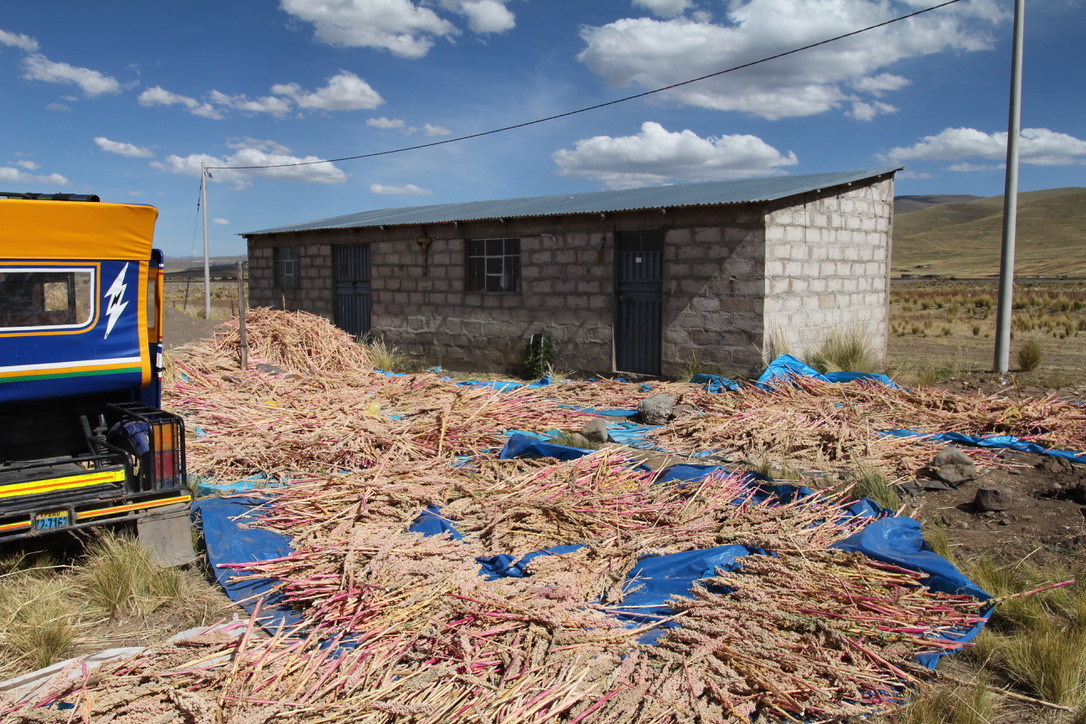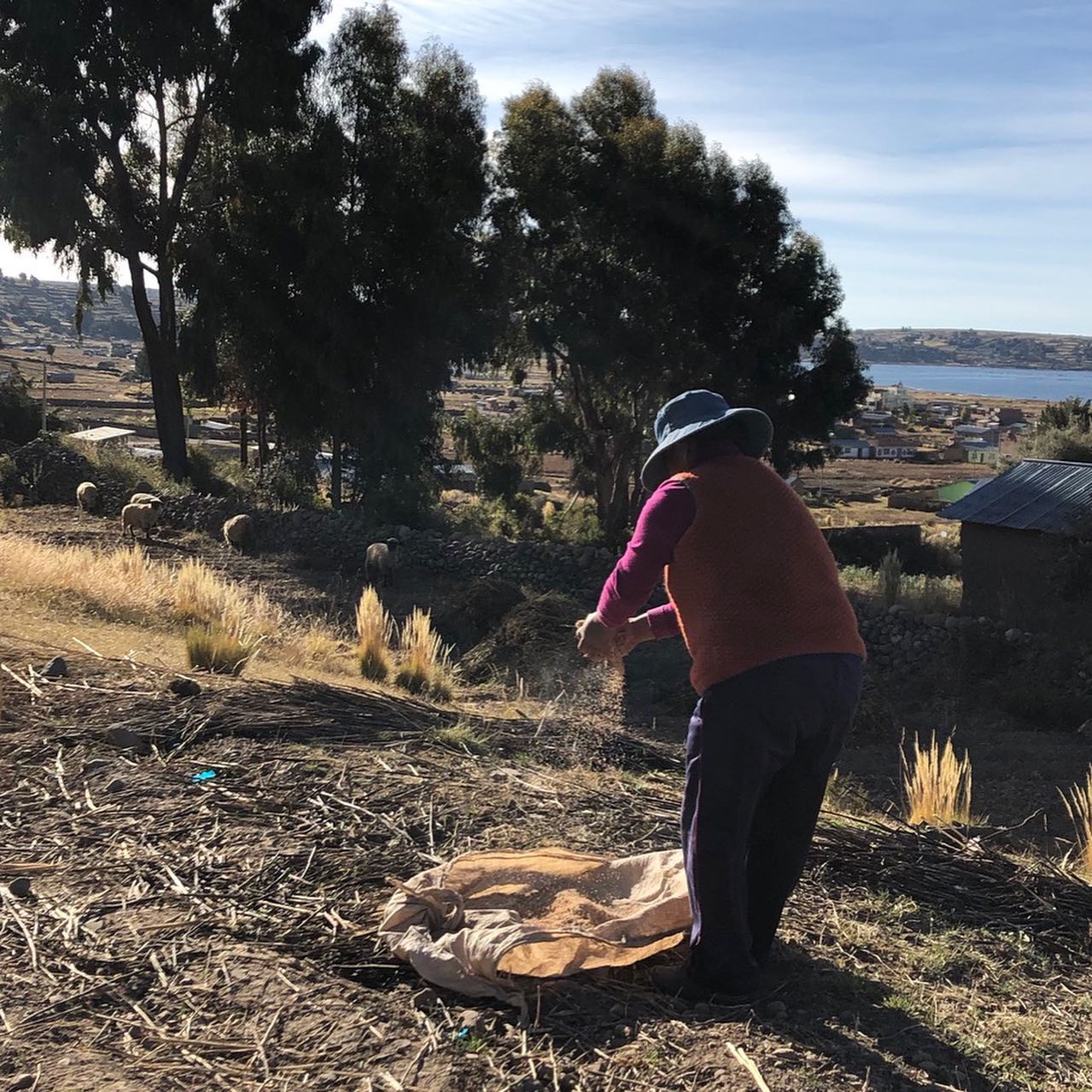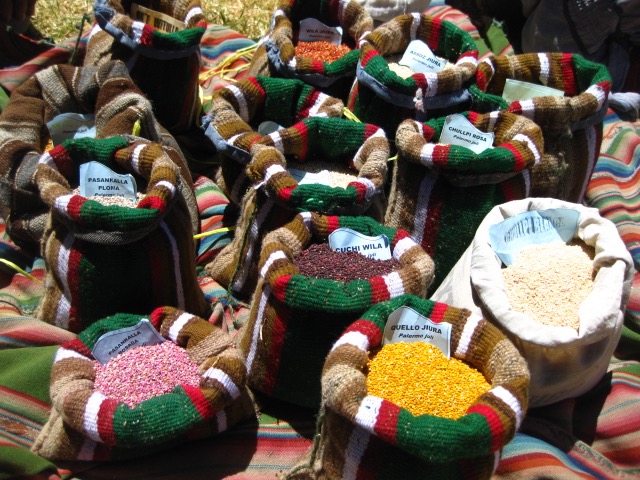
Global Quinoa and Andean Foodways
By Fabiana Li and Claudia Urdanivia
Variously advertised as an “ancient grain,” “superfood,” or “grain of the future,” quinoa has become a highly desired global commodity. Once grown primarily by campesinos (peasant farmers) in the Andes for their own consumption, it is now commonly featured in restaurant menus and supermarkets in urban centres around the world. Some health-conscious consumers emphasize quinoa’s nutritional value: it is high in protein, gluten-free, and suitable for today’s variety of dietary needs. We could just call it clever branding, but the recent fascination with quinoa extends beyond marketing trends targeting food enthusiasts. Scientists and development experts have also taken an interest in quinoa’s potential as a crop to feed the world. Quinoa’s adaptability to different climates and growing conditions make it an important crop in the face of climate change, and the Food and Agriculture Organization (FAO) has called it “our new ally against hunger.” [i] The FAO promoted its consumption and production around the world and touted quinoa’s potential as a tool for economic development. These various attributes contributed to the United Nations designating 2013 as the International Year of Quinoa.
The promise of quinoa – tied to its purported nutritional, environmental, and economic potential – has contributed to its global popularity. What is less certain, however, is whether these benefits reach the Andean communities that have traditionally depended on quinoa and continue to grow it. In this article, we examine how some Aymara communities in Puno, Peru have experienced the globalization of quinoa. We focus on the challenges that campesinos face as they continue their traditional agricultural practices in a global economy that disadvantages small producers. We also explore the place of quinoa in the household economy and changes in diet that have minimized – but not eliminated – the importance of quinoa as a traditional food. The revaluation of quinoa in light of its international success raises crucial questions about the role of small farmers in the global food system and the impact of consumer demand for South American quinoa products.
In recent years, quinoa has been the subject of controversy due to the ethical quandaries associated with its increased consumption in North America and Europe. Amidst a flurry of media coverage in the early 2010s (coinciding with the International Year of Quinoa), The Guardian newspaper even suggested that an insatiable global appetite for quinoa is putting it out of the reach of the Andean farmers who grow it.[ii] This argument that has been surprisingly resilient, even though more recent studies have revealed the complex consequences of the “quinoa boom.”[iii]
The idea that Andean farmers are being priced out of their traditional food continues to trouble guilt-ridden consumers who wonder how the demand for quinoa affects the livelihoods of small farmers. These concerns signal an increased awareness about the impact of our food choices and a growing interest in “ethical eating” in response to the environmental crisis and global inequality. But making a direct link between increased quinoa consumption in “wealthy” countries and lack of access to it in traditional quinoa-growing communities overstates a cause-and-effect relationship while disregarding history, changes in production and consumption over time, and the agency of farmers who make choices about how best to support their families. Of course, these choices are constrained by a global food system that does not make it easy for small farmers to earn a good price for their harvests or to access a variety of healthy foods.
This article draws on our anthropological research in quinoa-growing communities in the Lake Titicaca region, where quinoa originated. We visited communities and interviewed farmers in Puno, Peru in 2012 during the early stages of the quinoa boom (Urdanivia) and in 2019 after quinoa prices and demand had levelled off (Li). Our research highlighted the diversity of experiences of farmers who grow quinoa for subsistence and for the market. In Aymara communities that practice traditional agriculture, the increased demand for quinoa has had mixed effects on people’s livelihoods. On the one hand, small farmers’ high expectations of quinoa as a profit-making crop have not been met, and many small farmers have not had access to the kind of government support, training, and investment required to compete in the global market. On the other hand, the growing market demand for quinoa has coincided with a revalorization of the Andean crop by people across the world, including researchers and everyday consumers, which has renewed interest in quinoa production and consumption in rural communities.

Quinoa in the campesino household economy
On a crisp September day at the start of the planting season, Luisa and Cesar, a couple in their 30s from the campesino community of Juli, prepared their land for quinoa seeding. They used hand tools, working seamlessly alongside one another, making this difficult task appear effortless. Luisa and Cesar owned a small but not insignificant amount of land: 8 hectares that allowed them to plant the essential crops of the region. These include potatoes, quinoa, grains such as oat or barley, and leguminous plants. According to the typical system of crop rotation (known as aynoka in Aymara), these crops are planted in succession each year, after which the land is ideally allowed to rest for 4 to 5 years. The communal aynoka system is designed to preserve soil fertility, and does not lend itself to intensive agriculture or large-scale export production. Even in their individual plots of land, farmers typically employ this crop rotation system, although recently there has been a major reduction in fallow periods.
The microclimate of Lake Titicaca, with slightly warmer temperatures than other high-altitude quinoa-growing regions, allows for fishing and the cultivation of a wider variety of crops. Yet despite the advantage of a microclimate, Aymara communities along the lakeside region experience significant pressure on land resources, which limits their production. Campesino communities in Puno are characterized by minifundios (smallholdings) or fractured parcels that have been divided up among families with each generation, and many farmers have only minimal access to arable land. Campesinos face other challenges due to the changing climate and unpredictable growing conditions. Untimely rains, hail, frost, pests and disease can impact quinoa crops, and depending on the year, farmers might only produce enough for their own family’s consumption, with a small amount left over for sale. Each year, a portion of the harvests is stored for future consumption, thus contributing to food security in case of a bad harvest in the coming years.
Luisa and Cesar said they were glad to grow quinoa because it contains important vitamins and keeps them well fed. In spite of that, the couple noted that they only ate quinoa once a week because they didn’t have enough time to prepare it. In addition to post-harvest processing (drying, cleaning, and storing the seeds), home-grown quinoa must be washed numerous times in order to remove the saponins that give it a bitter taste. Quinoa cultivated by Aymara farmers in Puno has been traditionally destined for home consumption, but campesinos have experienced a shift in dietary habits over the years. The most notable changes include using rice in place of quinoa; wheat to replace artisanal flour made from quinoa; and pasta to replace quinoa and other cereals that were traditionally used for soups. Typical dishes using quinoa are still prepared (especially after the harvest and for special occasions), but the convenience and availability of other foods like rice and pasta often makes them more attractive than quinoa, especially for the younger generation.
Some North American consumers are concerned about that the global appetite for quinoa is taking it away from campesinos who grow it, but the shifts in dietary patterns in Andean communities are not new. Rather, changes in eating habits result from decades of changes in land tenure and the local economy: the breakup of hacienda system, rural-urban migration, wage-labor, and food aid programs have all affected the consumption of traditional foods. Over time, campesinos have transitioned from a diet based on what was produced on the land to one that incorporates foods from the market. Of course, quinoa farmers are not a homogenous group, and there are many factors that produce socio-economic differences and influence food consumption: the quantity and quality of land cultivated, the number of livestock owned, off-farm labor, and other non-farm business activities that complement their livelihoods and generate cash for food and household purchases.
Quinoa consumption also varies according to social differences and in urban or rural settings. Before its global popularity added to its prestige, quinoa was looked down upon as an “Indian food,” part of the legacy of colonialism and discrimination against indigenous people. Even though indigenous foods have been historically marginalized and undervalued, quinoa continues to have a place in the campesino diet. Moreover, quinoa’s international notoriety and recent commodification has brought renewed interest in Andean crops in rural communities. For example, various events and campaigns to promote quinoa consumption (like a “Regional Quinoa Day”) [iv] aim to shift popular perceptions of quinoa from an export commodity to a local food.
Quinoa export markets
With the initial excitement of the International Year of Quinoa, farmers were happy to benefit from high quinoa prices.[v] But after prices began to decline in 2014, many felt that growing quinoa for the market did not justify the effort and investment required to produce it. In the aftermath of the quinoa boom, their strategy has been to intermittently sell small amounts of quinoa to either intermediaries or through their farmer’s association to gain a little extra income. Some Aymara farmers we spoke to referred to quinoa as a “caja chica” (petty cash) that they could turn to in case of emergencies or household needs.
Campesinos often engage in other activities in addition to agriculture, such as livestock farming and handicraft making, and their income is mostly unstable. With a little extra earning from quinoa sales, farmers are able to purchase school supplies and school uniforms for their children, buy fodder for their cattle, pay bills, purchase goods in the local marketplace and even invest in the education of their children. Incomes derived from quinoa varied greatly, particularly among farmers who had small landholdings compared to those who were renting their land. Those with the smallest landholdings, for instance, would direct most of the quinoa for home consumption.
For Aymara farmers like Luisa and Cesar who struggled to make a profit from quinoa, membership in a farmer’s association seemed like an attractive option. Some quinoa growers believed they could gain a better price by selling larger quantities to private firms, and that their product would be valued for its high quality and appreciated more if sold collectively. When they sold to intermediaries, farmers complained that their product would be mixed with lower-quality quinoa from other farmers who did not produce in the same way. Belonging to a farmer’s association could bring other benefits, like participating in local, regional, or even national festivals and fairs to sell processed quinoa products or present regional quinoa dishes in gastronomy contests. Luisa, for example, enjoyed participating in the association and the fairs that featured quinoa products and cooking demonstrations, as this allowed for her crop to be valued.

Farmers were also enthusiastic about belonging to an association because it could give them more leverage in negotiating the price of their quinoa and the organizations provided support and training. In order to access these benefits, however, farmers had to have the resources and knowledge to be capable of producing a high-quality product that met the demands of exporters. Farmers also needed to develop business and marketing skills, which were offered at trainings from NGOs and other rural development projects but were quite limited.
Some farmers thought they could sell their quinoa directly to an exporting company through an association, but this may not have been the case, as quinoa often passes through many channels before reaching its export destination. This lack of transparency in the quinoa commodity chain poses a challenge for farmers wanting to benefit from the increased demand for quinoa and for consumers wanting to support traditional quinoa-growing communities through the purchase of South American quinoa. While growing demand and higher prices for their product can generate gains for some producers, the export market does not provide a reliable source of income for small farmers who need it most.

Quinoa consumers in the global food system
What can the story of quinoa teach us about global food systems and our role as consumers? The increased popular awareness among consumers about where our food comes from and how it is produced is a positive development, but it often fails to capture the complexities of the food system while providing misguided solutions focused on market-based mechanisms (export production as good or bad) and individual consumer choices (eating quinoa or not).
As we have seen in our research, however, fluctuations in quinoa consumption in campesino communities does not relate solely to international demand. Consumption of quinoa is influenced by history, migration, globalization, and changing traditions. Dietary habits are also shaped by desires for convenience and less labor-intensive foods, changing tastes, and the availability of other foods (from imported products to a greater diversity of local goods available for purchase). The diets of campesino families could also be influenced by recent local and international efforts to promote quinoa products that are changing the value and meaning of quinoa in Andean communities.
In Puno’s quinoa-growing Aymara communities, the globalization of quinoa consumption has been a mixed blessing. In some cases, it has provided an additional source of income and motivation to grow a crop that had been disparaged and not given as much importance as it has today. But the increased commercialization of quinoa could have other consequences in the long-term: decreased biodiversity, as more farmers grow the commercial white quinoa instead of other native varieties, and more pressure on fertile land if it is used more intensively. As quinoa production also becomes more globalized, farmers in Puno are seeing increased competition from other regions and countries, with larger landowners growing primarily for the market. These challenges have led to a push by farmers to create a Protected Designation of Origin to safeguard and promote the special place-based characteristics of Andean quinoa.[vi]
The limitations of market-based mechanisms to improve farmer’s livelihoods point to the importance of promoting quinoa consumption at the local and national level, as well as the need for agricultural policies and government programs that support small farmers. Some experts have suggested using local adapted quinoa varieties (landraces) to produce value–added products such as quinoa flakes, energy bars, flours, cookies, and much more. However, investing in these types of projects would be costly for farmers, who could benefit from more support from private and governmental agencies. Credit for farmers, insurance for crops, increasing the types of programs that support small business ventures by farmers, and increasing the number of extension agents to provide technical assistance support for farmers, are just some initiatives that would assist small quinoa producers.
Currently, the global food system disproportionately benefits retailers and large exporters, who make immense profits and have the most access to capital and power. The prices that farmers are paid for their crop erratically fluctuates based on supply and demand and when they are not connected to an entity that will pay a fair price for their crop (as is often the case), in worst case scenarios, farmers can end up spending more to produce than what they will earn by selling their crop. Global consumers should continue to demand a fairer distribution of profits that will benefit small farmers, promote sustainable agricultural practices, and increase transparency along the food chain. However, the idea that we can make a difference by buying or not buying a particular food like quinoa simplifies the multiple and sometimes untraceable nodes of the quinoa commodity chain. It also risks erasing the agency of Andean quinoa farmers who—by making decisions about when to grow, store, sell, or consume quinoa—seek to enhance their livelihoods and well-being within the constraints of our globalized food system.
[1] Food and Agriculture Organization of the United Nations (2013, February 20). Launch of the International Year of Quinoa. Retrieved from http://www.fao.org/news/story/en/item/170254/icode/
[1] Blythman, Joanna. (2013, January 16). Can vegans stomach the unpalatable truth about quinoa? Retrieved from https://www.theguardian.com/commentisfree/2013/jan/16/vegans-stomach-unpalatable-truth-quinoa
[1] Tanya M. Kerssen (2015) Food sovereignty and the quinoa boom: challenges to sustainable re-peasantisation in the southern Altiplano of Bolivia, Third World Quarterly, 36:3, 489-507, DOI: 10.1080/01436597.2015.1002992
[1] Ascue Arostegui, Gloria Alcira. (2019, March 27). Exitosa participación de productores de la region Puno en el “Día Regional de la Quinoa 2019. Retrieved from https://www.agropuno.gob.pe/exitosa-participacion-de-productores-de-la-region-puno-en-el-dia-regional-de-la-quinua-2019/
[1] McDonell, Emma (2018, March 12). The Quinoa Boom Goes Bust in the Andes. NACLA Report. Retrieved from https://nacla.org/news/2018/03/12/quinoa-boom-goes-bust-andes
[1] Bolivia busca denominación de origen para la quinua y Perú sería desplazado. (2020, January 14). Retrieved from https://www.pachamamaradio.org/nacional/6133-bolivia-busca-denominacion-de-origen-para-la-quinua-y-peru-seria-desplazado
* This article was published by Food First (Institute for Food & Development Policy)(July 2020)
Fabiana Li is a Peruvian-born anthropologist whose current research focuses on the politics of quinoa production. She is the author of Unearthing Conflict: Corporate Mining, Activism, and Expertise in Peru (2015) and articles on resource extraction and environmental conflicts in Latin America. She is an Associate Professor of Anthropology at the University of Manitoba, Canada.
Claudia Urdanivia is a community development practitioner and food systems professional. She is currently working for NYC Parks GreenThumb with community gardeners in the Bronx. She holds a Master’s Degree in Anthropology from Hunter College and has published in Anthropology Now about her fieldwork in her homeland of Peru, which centered on the local impacts of the global market expansion of quinoa.